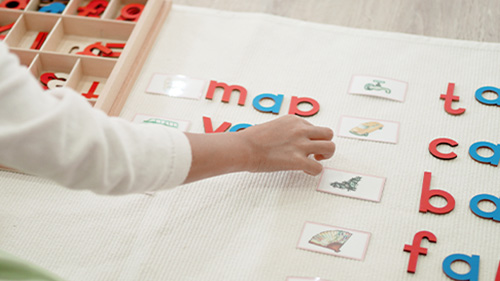Teaching Strategies to Help Students Master Grade-Level Standards
Spring is in the air, and school children all across the nation are entering the last leg of the academic year. But before the final bell rings, many...
AP & Honors Mathematics
Explore Wiley titles to support both AP and Honors mathematics instruction.
Literacy Skills & Intensive Reading
Connections: Reading – Grades 6–12
Empower student success with a proven intensive reading program that develops strong reading skills in striving readers.
Drama, Speech & Debate
Basic Drama Projects 10th Edition
Build students’ confidence and competence with comprehensive, project-based theatre instruction.
Literature
Connections: Literature
Support learners as they study dynamic, relevant texts and bring the richness of diverse voices to students through literature.
Literature & Thought
Develop critical thinking, reading, and writing across literacy themes, genres, historical eras, and current events.
Language Arts
Vocabu-Lit® – Grades 6–12
Help students build word power using high-quality contemporary and classic literature, nonfiction, essays, and more.
Connections: Writing & Language
Help students develop grammar, usage, mechanics, vocabulary, spelling, and writing and editing skills.
Reading/English Language Arts
Measuring Up to the English Language Arts Standards
Incorporate standards-driven teaching strategies to complement your ELA curriculum.
English Language Learners
Measuring Up for English Language Learners
Incorporate research-based best practices for ELLs with an approach that includes a focus on language acquisition strategies.
Mathematics
Measuring Up to the Mathematics Standards
Incorporate standards-driven teaching strategies to complement your mathematics curriculum.
Foundations
Measuring Up Foundations
Help students master foundational math skills that are critical for students to find academic success.
Science
Measuring Up to the Next Generation Science Standards
Give students comprehensive NGSS coverage while targeting instruction and providing rigorous standards practice.
Assessment
Measuring Up Live
Deliver innovative assessment and practice technology designed to offer data-driven instructional support.
For a better website experience, please confirm you are in:
2 min read
Measuring Up Apr 3, 2024 4:54:54 PM

Spring is in the air, and school children all across the nation are entering the last leg of the academic year. But before the final bell rings, many students will take end-of-year state assessments designed to gauge their academic aptitude and growth. For several children, just the idea of testing can induce anxiety and trepidation, causing them to perform poorly. Many students never truly become comfortable with the testing process. The format of these tests can throw off even the brightest pupils, which is why forward-thinking educators must prepare their students not only for the exam content, but also for the format to help improve achievement and progress. Taken together, achievement and progress illustrate how well students perform against the standards, but also measure their growth over time, giving educators a well-rounded view of a student’s learning accomplishment.
Practice makes perfect – a mantra that is especially true when it comes to standardized tests.
Leading psychologist and MacArthur Fellow Angela Duckworth highlights “intentional practice” as being key to attaining optimal skill development. Practice must have a specific intent, and match both the current level of skill development and the next targeted level.[1] Practice materials that strengthen students’ critical-thinking skills and demonstrate how to connect prior knowledge with real-world examples can help them solve even the most complicated test questions. This process helps to make meaning, building on what they know to what standards they need to master.
The testing environment itself can be a source of stress, potentially leading to lower performance. Providing students with engaging materials that emulate the tests is great practice that familiarizes them with not only the content and standards, but also the format they’ll soon encounter. Improving students’ comfort with their environment puts them at ease and allows them to concentrate on answering test items. Working with students to prepare them not only for what they’ll see on the exam, but also providing strategies for how to break down questions and work through content to get answers, builds critical thinking and test taking skills. As one teacher notes, “Comfort and a positive attitude can go a long way towards easing anxiety”[2] Furthermore, research shows that praising students’ efforts rather than their talents helps students perform better.[3].
Familiarity with tech-enhanced item types such as drag and drop, multiple select, constructed response, and equation builders, helps students acclimate to the testing environment. Using these types of items prior to testing day allows students to focus on the content and look beyond how to answer the question.
Scaffolded instruction enables educators to reach all learners, from struggling learners to English Language learners to the gifted and talented students, allowing educators to tailor instruction and target each student’s skill and standards deficiencies. Through instructional scaffolding, educators systematically target each student’s needs to enhance learning and aid in the mastery of new skills.
End-of-year exams are right around the corner. Now is the time to improve students’ problem-solving abilities, critical-thinking skills, and boost overall testing performance with rigorous content and support tools to help them ace their assessments. Here are some tips to try with your students today:

Spring is in the air, and school children all across the nation are entering the last leg of the academic year. But before the final bell rings, many...

As a public educator, one of the most vital things that I try to get my students to understand is how all the information they learn works together...

Early in a school year it can be a real challenge to know how to begin teaching students critical skills they need to score on the AP® U.S. History...

Congratulations—or maybe condolences? You just found out you are teaching an Advanced Placement® (AP) English class next year. Whether it’s AP...

An exit ticket can be an effective way to determine if students are understanding what they are being taught. They provide immediate feedback, while...

Every time I open up Instagram, Facebook, or Twitter, I’m given the option to post to stories or urged to open the stories of others. Pictures that...

As an educator, there might be one question you dread above all others: “But when am I ever going to use this?”

National Dropout Prevention Center’s evaluation of Measuring Up reveals students experienced substantial academic progress

Summer is almost here. For many, it’s a time to relax and leave schoolwork worries behind. However, by the time school starts up again in the fall,...

In American K-12 public schools, English language learners (ELLs) make up over 10% of students. 10% may not sound like much, but that’s over 5...

Over the course of my career as a middle school ELA teacher, I’ve graded more writing pieces than I can count. I’ve graded late into the night, on...

As winter break approaches, classrooms across the country buzz with excitement—and a fair amount of distraction. December is a notoriously tricky...
